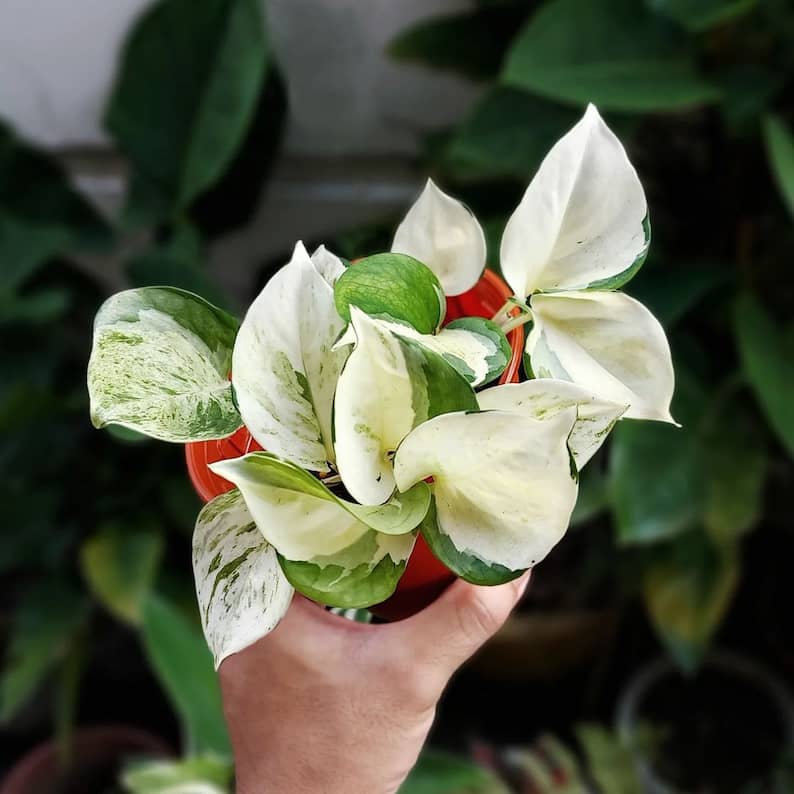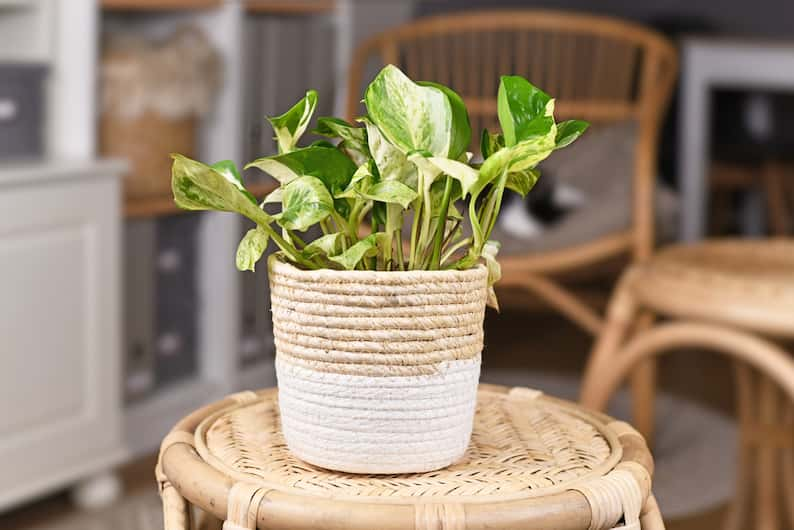Looking for a low-maintenance houseplant that is easy to care for? Look no further than the Harlequin pothos! This stunning plant with its striking patterns on its leaves is perfect for those who don’t have a green thumb – assuming you can find one.
That is, the Harlequin pothos is not only incredibly beautiful but incredibly rare. While many houseplant collectors would love to get their hands on one, it’s easier said than done, especially when there’s another type of pothos that is frequently mislabeled as one of these.
So keep reading to find out all about the Harlequin pothos – and, if you manage to strike gold and fine one, we’ll cover the best ways to care for your Harlequin pothos so that it stays healthy and looking its best!

Table of Contents
What is a Harlequin pothos?
The Harlequin pothos is a rare type of pothos that is part of the Araceae family. Native to Southeast Asia, the plant gets its name from its unique leaves, which are highly variegated with large patches of white coloring alongside some green throughout its foliage.
Beyond its striking looks, the Harlequin pothos’ scientific name is Epipremnum Aureum Harlequin. This can help to know as people often report that plants are sold under the label of “Harlequin pothos” when, in fact, it’s another type of pothos – most commonly the Manjula pothos, the scientific name of which is Epipremnum aureum Manjula.
Is Harlequin pothos the same as Manjula?
While the Harlequin pothos looks very similar to the Majula, they are two different plants. The confusion often arises as their variegation is similarly striking. However, the main difference is that the leaves of the Harlequin pothos tend to have more white and less light green than the Manjula.
When comparing the Harlequin pothos vs Manjula, it’s also worth mentioning that the Harlequin pothos is much rarer. This can lead to a situation where a plant that’s labeled as a Harlequin is actually the far more common Manjula pothos, meaning you shouldn’t pay that much for it.
That said, there’s no question that both are very beautiful plants and you really can‘t go wrong with having either of them added to a room.

Harlequin pothos care
The Harlequin pothos is a popular houseplant because it is very easy to care for. In fact, it is often recommended to beginners who are looking to get into plant care. The plant can tolerate a wide range of conditions, making it ideal for those who don’t have a lot of experience with plants.
Even if you forget to water your Harlequin pothos for a few weeks, it is unlikely to die. However, it is important to note that the plant will not thrive if it is neglected. If you want your Harlequin pothos to stay healthy and look its best, it is important to give it the proper care.
Watering
One of the most important aspects of caring for a Harlequin pothos is watering. The plant should be watered when the top one to two inches of soil has dried out, which will generally be about once a week. It is important to not overwater pothos, as this can cause root rot.
Back to basics: How Often to Water Your Pothos (So It Thrives)
Lighting
The Harlequin pothos does best in bright, indirect light. If you live in a place with low natural light, you can supplement with artificial light. The plant can tolerate a wide range of lighting conditions, but it will not thrive in complete darkness.
If you are unsure whether your Harlequin pothos is getting enough light, take a look at the leaves. If they are yellowing or browning, this could be a sign that the plant is not getting enough light.
Find out more: What Are Your Pothos’ Light Needs?
Temperature
The Harlequin pothos is a tropical plant, so it prefers warm temperatures. The ideal temperature range for the plant is between 60 and 75 degrees Fahrenheit (17°C to 25°C). If the temperature gets too cold, the leaves of the Harlequin pothos will start to turn brown and drop off.
Humidity
The Harlequin pothos does best in humid environments, like all types of pothos that thrive in humidity. If you live in a place with low humidity, you can increase the moisture in the air by adding a humidifier, placing the plant on a pebble tray, grouping plants together to encourage humidity or, as a short term option, misting the plant.
Fertilizing
The Harlequin pothos should be fertilized about once a month during the growing season. You can use a liquid fertilizer or slow-release pellets (with our top picks for the best pothos fertilizer being available here).
Be sure to follow the instructions on the fertilizer label, as too much fertilizer can burn the roots of the plant.
Where to buy Harlequin pothos
The Harlequin pothos is one of the rarest types of pothos so finding one for sale can be difficult. It’s best to check specialty plant shops or contact expert growers directly, as they are most likely to have cuttings. You may also sometimes find these online on Etsy.
The reason for contacting specialists in this area if your heart is set on having a Harlequin pothos is because you’ll often find plants advertised for sale that claim to be Harlequin, but are actually Manjula pothos. While there’s nothing wrong with the Manjula – indeed, it can be a much easier (and cheaper) way to get your hands on a beautiful, variegated pothos – at the end of the day, it’s not a Harlequin.
One other good strategy can be to check for people selling Harlequin pothos cuttings on Instagram by searching for relevant hashtags. However, just from a quick look at the time of writing this, I can see some people claiming to have the Harlequin when it’s actually a Manjula, so buyer beware.
Harlequin pothos are beautiful, easy-to-care-for plants that make a great addition to any home. By following the tips in this guide, and with a bit of luck by successfully tracking one down, you can keep your Harlequin pothos healthy and looking its best.
